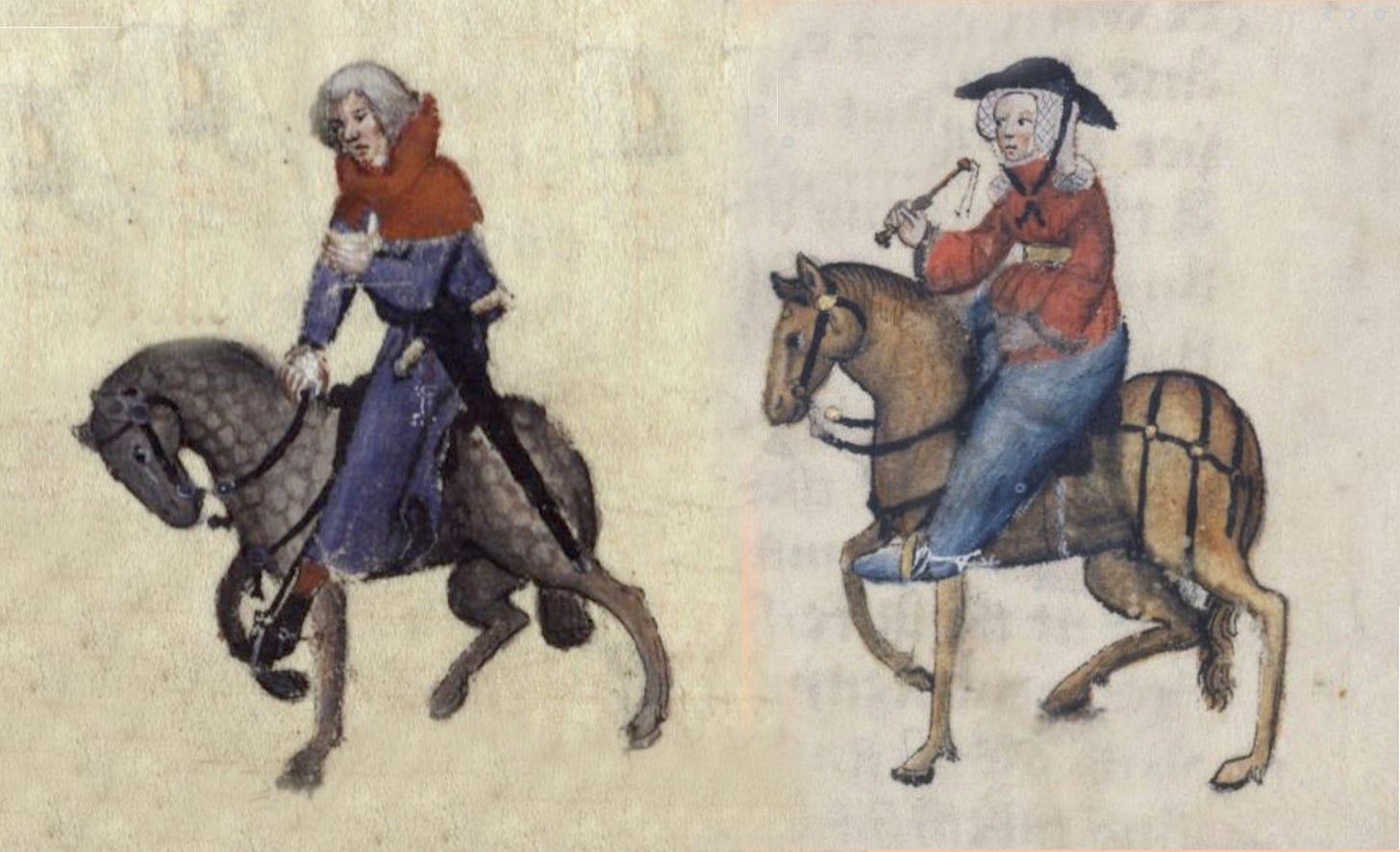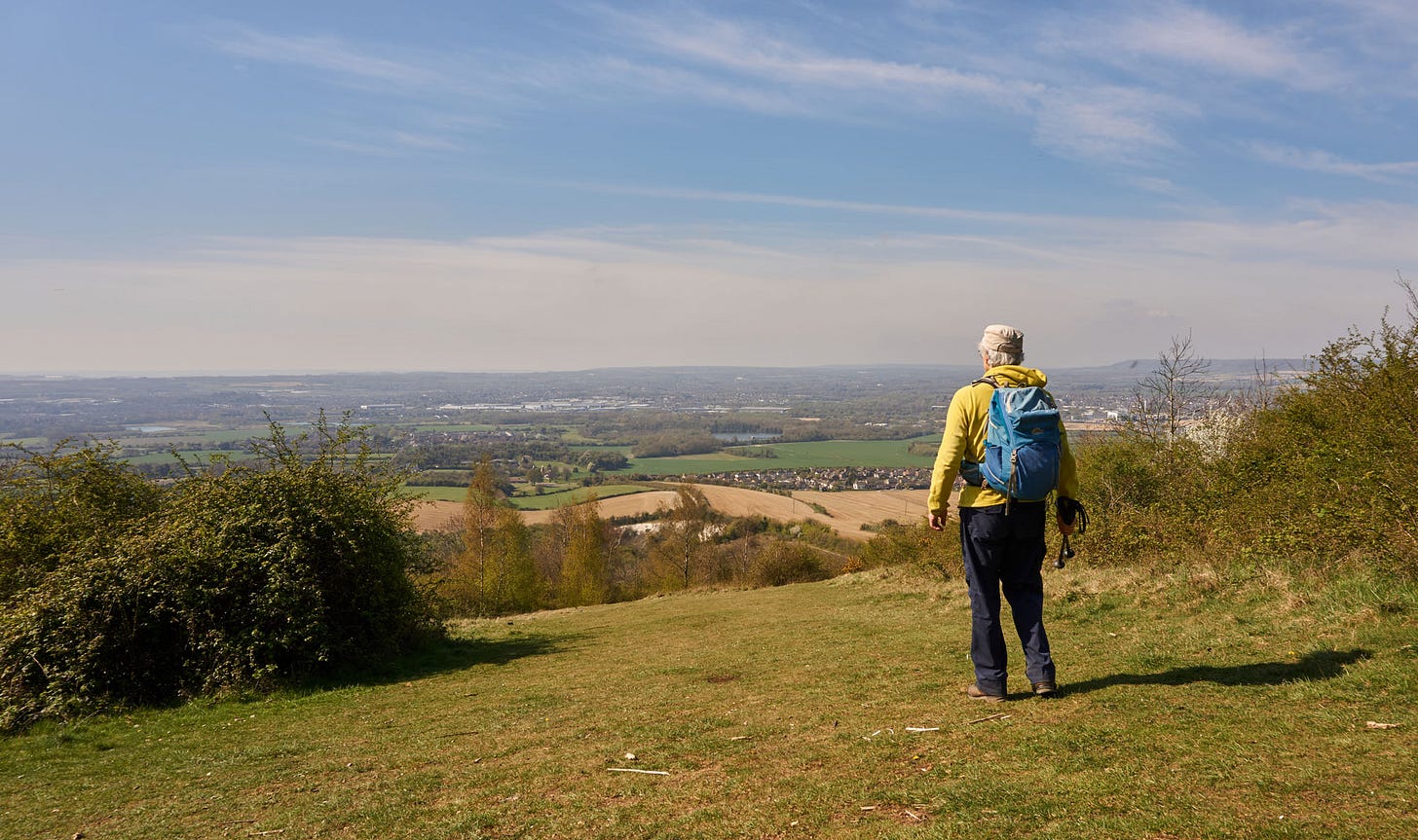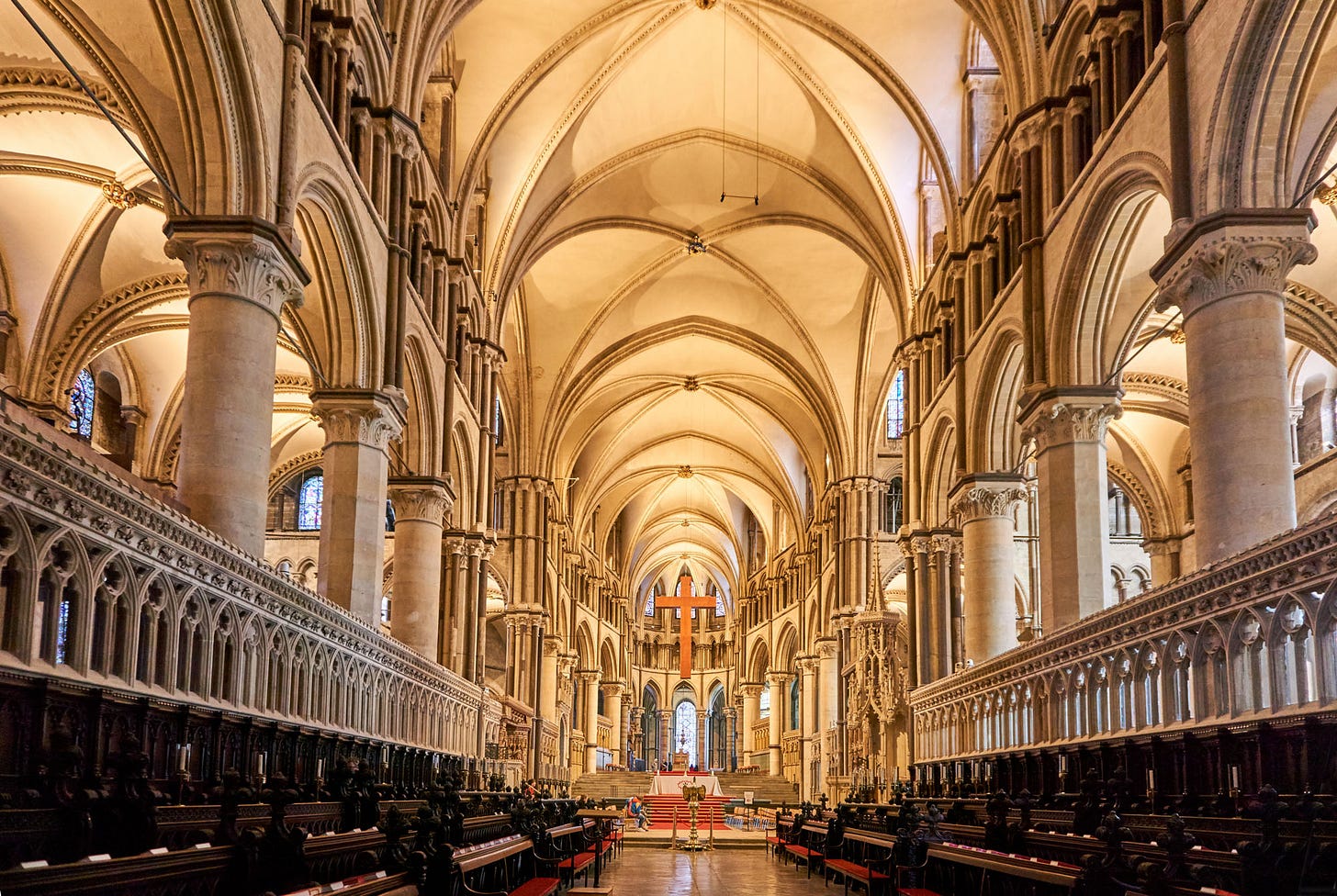A Chaucer Walk
Five days from London to Canterbury following English literature's first ever long-distance trail
Long distance walking across England: we've been at it, now, for almost 700 years. Which makes it worthwhile to go back to the beginning – which is the site of the former Tabard Inn in south-east London – and setting out to retrace the original Chaucer Walk. The 65 mile pilgrimage to Canterbury is the first great work of English literature, and also the first great walk.1

The 29 pilgrims have come in across London Bridge and gathered at the Tabard Inn at Southwark. The inn’s host takes charge of the rabble. Everyone’s going to tell four stories along the way, with a free dinner for the best one. And tomorrow they’re going to make an early start, highly desirable on any multi-day trek.
And madė forword early for to risė
To take our way there as I you devisė.
The Canterbury Tales: General Prologue
[E with dot over indicates one that's pronounced rather than silence; so ‘madė’ has two syllables.]
Southwark Cathedral is surrounded by even taller buildings: among the windings of the Borough Market it's not easy to find the thing. It was brand new in Chaucer's time, apart from the bits of it that weren't even there yet – and all in the hot new Gothic style with those pointy-top arches. It’s been further improved today with a café and shop accreted onto its southern side. Pick up your 'Pilgrim Passport' to stamp again at the other end, supposing you get that far. It’s also worth visiting for the small display of fossils dug up out of the Thames mud.
Tower Bridge can be ignored: it's been there scarcely more than a century. But look across to the Tower of London, built in the ten-seventies by the newly-arrived Normans. At journey's end, Canterbury Cathedral will be in the same white Caen limestone brought across from France.
Three miles through the late afternoon, and I spend my first night at Rotherhithe’s comfortable modern Youth Hostel.
In any 12-bed dormitory, the same question always: will there be a snorer? And if so, how many? Tonight there’s three of them. Which makes for inconvenient sleeping, but in literary terms is just right. It exactly matches the sufferings of the two young Cambridge students in the Reeve's Tale.
Having been cheated of their corn measure, and spent the afternoon chasing their horse around the marshes, they’ve been offered the spare bed at the miller’s.
This millere hath so wisely bibbed ale
That as an hors he fnorteth in his sleep,
Ne of his tayl bihynde he took no keep.
His wyf bar hym a burdon, a ful strong;
Men myghte hir rowtyng heerė two furlóng;
The wenchė rowteth eek, par compaignye.Canterbury Tales line 4162
This miller has so substantially imbibed ale
That like a horse he’s snorting in his sleep,
Nor of his tail behind he took no heed [he’s farting as well]
His wife bore him a bass accompaniment, full strong;
Men might hear their snoring two furlongs [400m] away;
The wench is snoring too, to keep them company.
There is a current ‘Augustine Pilgrim Way’ to Canterbury. But the route I’m taking by the Thames Path is more interesting, and more direct, and also more closely follows Chaucer. By the time the Reeve’s telling us about the students, the snoring miller, and what happens if you displace the baby’s cradle to the foot of a different bed, it’s 7.30 in the morning and they’re 4 miles into their journey, just passing Deptford.
London to Canterbury along the modern or the Mediaeval road system is about 65 miles: two days each way for the horse-borne pilgrims. My off-road route comes out at 135km or 85 miles, over five days of walking. Straight out of the youth hostel I’m crossing the Thames with the river boat to Canary Wharf. First reason, to cut out the big loop of the Isle of Dogs. Second and more important reason: so's to cross back again on the high-level cablecar installed by Boris Johnson.
The cablecar crossing’s even better if you've a four-year-old person to join you for this bit of the trip. One who, while still inside the Docklands Light Railway, has spotted the gondola cars climbing through the sky. "I'm so excited!" He spots the shadow of the moving cable-car and runs along inside it to find out if it goes at the same speed as a flying four-year-old. An irresponsible populist in charge of the city's infrastructure? A bad thing, obviously: but sometimes it can also be a lot of fun…
My first full day of walking takes in the Thames, some suburban parks, and a ruined abbey that used to be a staging point for pilgrims but is now just used for Sunday picnics – to end at an AirBnB in Erith. More pilgrims used to join the route here by a ferryboat across the Thames: the 14th-century equivalent of the Dartford Crossing that makes a low swooping shape against the sunrise.
Chaucer's lot left London in two hours. It took me a day and a half to pass under the M25 to a green riverside, the Darent Valley Path. After Dartford the path rises onto the North Downs: wide chalk lands, like Salisbury Plain but with pylons striding across the sky. The North Downs ridge: it’s so high and wild you can hear the motorways on both sides.
No, it’s not like it was back in 1387. Below me, most of the tree strips and hedges have gone, the fields resized for tractors rather than humans with horses. And then planted with yellow oilseed rape, or potatoes under plastic that shines across the valley floor like Thames mud. The air’s a haze of cars and industry.
But at South Fleet an ancient friary is still there, with a few patches of original stonework showing through the render. And, of course, the churches: many of them Mediaeval, one dedicated to St Margaret of Antioch who got swallowed by a dragon.
I’m now taking advantage of the ‘1066 King Harold Way’ from Stamford Bridge to Hastings, devised so as to come first of all in any alphabetical list of long-distance paths. But at the village of Cobham, the main lane is indeed Battle Street, as walked down by that tired army 960 years ago. And the inn here was also stayed in by Charles Dickens on his own long walks from London to his other home near Rochester.
Any large walking party tends to drop off the pace; the host needs to keep them all on the move
Lordings, quote he, I warn you all this rout
The fourthė partie of this day is gone.
Now for the love of God and of Saint John
Losė no time, as farforth as ye may.The Man of Law’s Prologue
Because I’ve measured this third day a bit short, and also not spotted the 550m of ascent in it. It’s early afternoon, and a fair way still to go to those motorway services east of Maidstone. Right now, though, there’s the Cock Horse Inn at Detling.
But first, quoth he, here at this alėstake
I will both drink, and biten on a cake.
The Pardoner’s Prologue
And having bitten my cake, on into the afternoon.
This south-facing chalk scarp is ideal wine country: in French naming convention, it’d be the Côtes de Kent. And its path, too, is quite like a sea-coast with its constant up and down, from scarp top to the field edges below.
It’s early evening by the time I get in. The motel in the motorway services area is surprisingly spacious and comfortable. But the supper options are limited to what people eat who are in cars: Mcdonalds, Costa, or a snack supper in a cardboard box from Leon.
Day four is along the original pilgrim path, a walkers’ direct line that’s occasionally overlain with the tarmac of today. It’s ideal for quick progress eastwards while swapping stories with my friend David, who’s come out by train for the day.
And yes, there's even a seventh reason for a pilgrimage. David's just off on a coast-to-coast backpack trip across the Highlands; and in a couple of weeks I'll be starting the Robert Louis Stevenson Trail through the hills of central France. Twenty miles a day of easy Kentish footpaths: we're here on a pilgrimage to get fit.
The off-white chalky path is firm and dry under our feet. On our left the thornbush blossoms sparkly white even on this dull day. On the right, lurid fields of yellow oilseed rape. Maybe, in the 21st Century, we can’t walk with Chaucer any more. But if we take time and effort to read ourselves into the Middle English, we can at least read the pilgrims’ banter and quarrelling and boasting as they go along: puzzle out their strange professions (Limitour? Manciple? Reeve?) and enjoy their insults, so much more hurtful than anything we’d want to say to our fellow walkers today.
And then, when it comes to walking with the Reeve and the Miller and the Wife of Bath: in the end we can retrace not only their feet but their feelings. Because we arrive at Canterbury Cathedral.
They take their pilgrims seriously at Canterbury. When I offer my Pilgrim Passport for stamping, they usher me in for nothing – so that was £1 well invested back at Southwark… The Pilgrim Officer offers an official welcome, and leads me on the pilgrim route through the cathedral. It’s the eastern end of it that was already there in the thirteen-eighties: big, thick columns, round-topped Norman arches, that pale limestone from Caen. The steps up the left-hand aisle, worn not at their front edges but right in the middle, from being ascended on knees rather than feet. The centre would have been filled with the martyr archbishop’s massive relic-holding memorial: the size of a London bus, shining in the gloom with so many jewels you could hardly make out the gold mountings in between. Henry VIII had it all torn down and taken away.
Three Archbishops have been murdered (plus one forced to resign over child protection scandals). But the one that counts is Thomas a Becket, murdered right here in the cathedral in 1170 after an ambiguous instruction from King Henry II. The monks scraped up his blood off the floor tiles, diluted it in plenty of water, and straight away started using it for healing the sick.
And specially, from every shirės endė
Of Engėlond, to Caunterbury they wendė,
The hooly blisful martir for to sekė,
That hem hath holpen whan that they were seekė.
Within a few years, Canterbury was a pilgrim destination to rival Rome and Compostella. Several of the more spectacular miracles are recounted, in the style of a graphic novel, in the windows on the north side: the Lame Sisters of Boxley, poor Eilward of Westoning, blinded and castrated for a burglary he didn’t do, Jordan Fitz-Eisulf’s son being raised from the dead. They’re a mix of original Mediaeval glass and Victorian restoration so good it’s hard to tell the difference.
There are also some impressive shelly fossils in the floor. Jurassic, I reckon.
Overnight is the Sun Inn, just two minutes from the cathedral. Yes, built in 1503. Yes, stayed in by Charles Dickens. First thing in the morning is the time to come back to the cathedral. To watch the light drifting through the empty stone spaces; to listen to the silence; to think back along 85 miles of fields and rivers, and 650 years of walkers coming before.
The route: Thames Path, Green Chain Walk, 1066 King Harold Way, North Downs Way. Accommodation booked on Booking.com a few days beforehand: but Substacker Dominic Frisby made a similar journey booking each night on the previous evening.
Actually one of two in Middle English: there’s also Sir Gawain's great trek across the winter Midlands on his Derbyshire-dialect quest for the Greene Knight.







Lovely read, and an inspiration to follow in your footsteps and those of others
You’re a long way south! I envy your French trip.